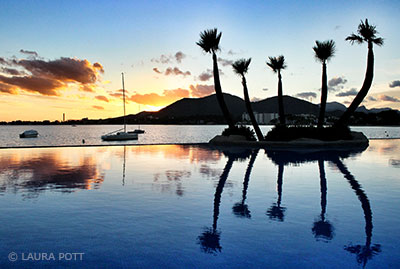Mallorca Weather
At the Balearic island of Mallorca, there is fine weather almost throughout the year. But by which characteristic values, the weather in Mallorca is characterised? A look at the weather reports is answering this question.
The Weather is Influenced by the Mediterranean Sea in Mallorca
Basically there is a classical Mediterranean climate at the Balearic Islands. While the summer periods regularly are pleasantly warm, there is no extreme cold during the winter time. The warmest month usually is August, the coldest one is February. However, the weather in Mallorca is not as stabile as in past times, that´s why the climate is much harder to foresee. But there is a tendency, that summers in Mallorca have become warmer during the last years. For example, there were record temperatures when the thermometer was at 35 degrees in August 2005.
The Golden Seasons: Spring and Autumn

The spring and the the autumn months are pleasant and extremely appealing in Mallorca. That´s why people call this time „the golden seasons“. Temperatures of around 20 degrees are not uncommon during the spring and the autumn months. Despite the temperatures are at their lowest point, many tourists come to experience the almond blossom. By this time, it is already green in Mallorca and there are summer temperatures at the latest in May. Summers in Mallorca use to be quite hot and dry. Temperatures of around 40 degrees are not unusual during the summertime. It is not raining a lot and the time between July and August is said to be the summer high season. The water temperature is around 20 degrees in May and June. Although in May there might be already summer air temperatures, the water requires a certain time to warm-up. Contrary to the development of the air temperatures, the water temperatures are adapted to the outside temperature about three to four weeks later. The development of the water temperature is also influenced by the local situation at the beaches. For example the water temperatures are much lower near steep creeks than at flat beaches. Since the average water temperature in Mallorca has increased during the last years, in some of the bathing areas, problems have occured. For example, because of the high number of mauve stingers and an excessive algal growth, some of the beaches had to be closed for several days.

Most Precipitation Falls in October
Rainfalls are first signs of the forthcoming rainy phase. They are already starting at the beginning of autumn – partly even in August. But the main rainy season starts in October. Thus, in October the rain is heaviest compared to the rest of the year. One of the consequences are floodings, which occur until temperatures are sinking relatively quickly. At the west coast, the rainy period lasts from October until January. In Palma, the rainy period ends in December. According to weather reports, there is only few snow during the winter time. Winters that are mild and slightly humid are also typical for the island. The average winter temperatures are about ten degrees. The Tramuntana mountains has been the Mallorcan region where snow was falling regularly. However, during the last years, snow was falling everywhere on the whole island.

Good to know!
In Mallorca, there is a subtropical island, where the sun is shining around eight hours a day. The average rainfall is 400 millimeters per year in the southern part and approximately 1,400 in the southern part. The mild and calm weather conditions that prevail from late December to January, are called, Calmes.


